Popular
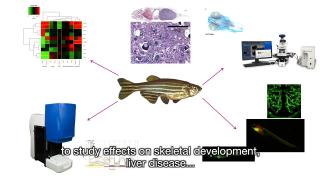
Innovation examples
HealthToxicology
Zebrafish in toxicity testing
Zebrafish are increasingly recognised as a useful model for toxicity testing of chemical substances. Testing strategies are becoming more based on mechanisms of toxicity structured in adverse outcome pathways describing the chain of events leading to toxicity or disease. Using a battery of dedicated in vitro and in silico assays, insight can be gained in how exposure leads to disease. For certain diseases it is known that toxicity relies on the interaction between different organs and cell types, which requires research on whole organisms in addition to simple in vitro models. The zebrafish is considered a valuable whole organism model in a mechanism-based testing strategy. At RIVM, the zebrafish embryo model is used for testing the effect of chemical substances on several adverse outcomes and diseases.
For more information see: https://ehp.niehs.nih.gov/doi/10.1289/EHP9888; https://doi.org/10.3390/ijerph18136717; www.linkedin.com/in/harm-heusinkveld

Projects and initiatives
HealthInnovationPolicyBeginner
We all want a safer world for humanity, animals and the environment: Transition Animal-free Innovation
Why is the transition to animal-free research so important? What are animal-free models? How does TPI (Transition Animal-Free Innovation) encourage their development and use? And who are we working with to make this happen? We explain this in our animation.
More and more animal-free tests and research methods are becoming available, but not all research questions or safety tests can be answered in this way yet. In addition, the validation, qualification and acceptance of non-animal innovations still lags behind. Therefore, the Dutch Ministry of Agriculture, Nature and Food Quality (LNV) stimulates the development and application of animal-free innovations. This is done with the partner programme Transition Animal-free Innovation (TPI).

Meetings & conferences
HealthIn vitroAdvanced
3D tumor models for CAR-T-cell therapy optimization
Chimeric antigen receptor (CAR) T-cell therapy accounts for one of the most promising therapeutic advances in cancer immunotherapy. In this form of adoptive cell transfer, T-cells of a patient are engineered to express so-called ‘CARs’, in which the antigen-recognition capacity of antibodies is combined with T-cell activating domains. So far, CAR-T-cell therapy obtained its most impressive results in hematological malignancies resulting in the approval of five CAR-T cell products by the FDA for hematologic indications. However, CAR-T-cell therapy has not mirrored its success in solid tumors. The poor efficacy of CAR-T-cell therapy in solid tumors has, in part, been attributed to the lack of understanding in how CAR-T-cells function in a solid tumor microenvironment. Classical validation methods rely on the use of specificity and functionality assays in 2D models against adherent target cells or target cells in suspension. Yet, by using these models, observations made in vitro may differ greatly to an in vivo situation where tumors are engrafted in 3D structures. We developed a more relevant and translational 3D tumor model using eGFP+ target cells. This allows us to couple 3D tumor cell killing by CAR-T-cells to live-cell imaging, providing an efficient quantification of target cell death. As proof- of-concept, we used a 3D model of eGFP+ glioblastoma cells and CAR-T-cells targeting a pan-cancer antigen. This 3D glioblastoma model allowed us to show that classical scFv-based CAR-T-cell therapy of glioblastoma cells can be improved by nanoCAR-T-cells. Furthermore, combining nanoCAR-T-cell therapy with a genetic approach of nanobody-based anti-PD-L1 immune checkpoint blockade further increased the cytotoxicity of the nanoCAR-T-cell therapy.
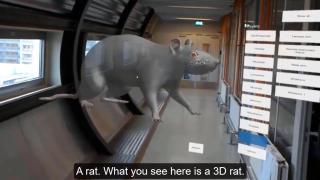
Innovation examples
EducationInnovation
Avatar Zoo - teaching animal anatomy using virtual reality
Animals are essential to train the next generation of scientists understand diseases and develop treatments for humans as well as animals. Therefore, animals are used for educational purposes. Technologies such as Virtual Reality and Augmented Reality can be employed to reduce the number of animals in the future. Prof. Dr. Daniela Salvatori is working on the development of 'Avatar Zoo' together with UMCU and IT. Live animals are replaced by holographic 3D in this flexible platform. With these holograms one is able to study the anatomical, physiological and pathological systems and processes of all kinds of animals.
Avatar Zoo won the Venture Challenge 2021 for the development of virtual reality models that can be used for anatomy classes and practical training.
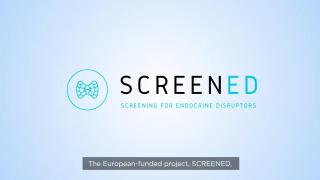
Projects and initiatives
HealthIn vitroOrgan-on-Chip
SCREENED: developing 3D thyroid models
The European collaborative project SCREENED aims to develop three-dimensional (3D) cell-based in vitro tests to better characterize the effects of endocrine disruptors (EDs) on thyroid gland function. This method will overcome the limitations of existing tests, being more sensitive at low doses of exposure to chemicals, and enabling the prediction of their toxicity on human health in a sex-specific manner. The ambition of the SCREENED project is that these new 3D in vitro tests, as well as the increased knowledge about adverse reactions after exposure to EDs, will be used for regulatory purposes, ultimately to improve human health.

Innovation examples
HealthIn vitroOrgan-on-Chip
Stem cell derived Vessels-on-Chip to study brain disorders
Dennis Nahon is a PhD candidate in the Department of Anatomy and Embryology at the Leiden University Medical Center. In his research, under supervision of Dr. Valeria Orlova (https://www.orlovalab.com/) and Prof. Dr. Christine Mummery, he aims to mimic a blood vessel in the brain by combining different stem cell derived cell types, in a 3D Vessel-on-Chip model. Here, an example of these in vitro blood vessels is shown in which certain brain cells known as astrocytes (in white) interact with the blood vessels (in red). This model paves the way for investigating brain vessels outside the human body, while reducing the need for animal models.
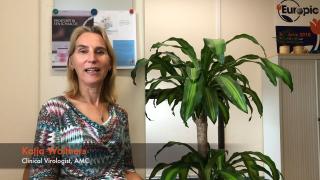
Innovation examples
HealthInnovation
Katja Wolthers, Amsterdam UMC: Virology using human models - let's show some guts!
To study viruses that make people sick, we often use laboratory animals. However, virus infections in animals are different than in humans. New 3D culture models or 'organoids', which look like human organs in a petri dish, offer a unique opportunity to investigate how viruses enter the human body and cause disease. Our research focuses on enteroviruses such as polio. Due to vaccination, polio is rare, but other enteroviruses are increasingly a threat to young children and patients with impaired immune defenses. There are no medications available, because knowledge about infections with enteroviruses is limited. In our research we use organoids to see how enteroviruses enter the human body and by which means you can prevent that, without the use of laboratory animals. With this project we want to show that our technique can replace the use of laboratory animals in virus research.
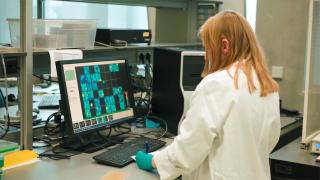
Innovation examples
ToxicologyInnovationIn vitro
Human neuronal cell models for in vitro neurotoxicity screening and seizure liability assessment
Anke Tukker was a PhD candidate in the Neurotoxicology Research group of Dr. Remco Westerink at the Institute for Risk Assessment Sciences at Utrecht University. Dr Westerink’s research group investigates the mechanisms of action of toxic substances on a cellular and molecular level using in vitro systems. Anke's project aimed to develop a human induced pluripotent stem cell (hiPSC)-derived neuronal model for in vitro neurotoxicity screening and seizure liability assessment. Using micro-electrode arrays (MEAs), she showed that these models mimic in vivo neuronal network activity. When these hiPSC-derived neurons are mixed with hiPSC-derived astrocytes, they can be used for in vitro seizure liability assessment. Comparing these data with data obtained from the current used model of ex vivo rodent cortical cultures, she found that these human cells outperform the rodent model. Here research thus contributes towards animal-free neurotoxicity testing.
Anke Tukker has won the public vote of the Hugo van Poelgeest prize 2020 for her research on human neuronal cell models for in vitro neurotoxicity screening and seizure liability assessment.
Neurotoxicology Research Group, IRAS, Utrecht University: https://ntx.iras.uu.nl/NTXatIras
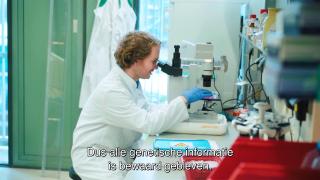
Innovation examples
ToxicologyIn vitroOrgan-on-Chip
Human pluripotent stem cell derived cardiomyocytes for disease modelling and drug discovery
Berend van Meer did his PhD research in the research group of prof. Christine Mummery at the department of Anatomy and Embryology of the Leiden University Medical Center. In this group, human pluripotent stem cell derived (Organ-on-Chip) models are being developed, mostly cardiovascular models. The work of Berend aimed to understand how well these stem cell based cardiac models can predict the effect of (well-known) drug therapies in patients. Importantly, the outcomes of the experiments were compared to very similar measurements in rabbit heart muscle cells. And while animal models predicted less than 70% correctly, the human stem cell based models predicted almost 80% of the expected effects correctly. The research contributes to understanding the relevance of stem cell based models and strengthens the confidence regulators and pharmaceutical companies have in such models as animal alternatives in the drug development pipeline.
Berend van Meer has won the Hugo van Poelgeest prize 2020 for his research on human pluripotent stem cell derived cardiomyocytes for disease modelling and drug discovery.
Christine Mummery's lab on Heart on Chip, Disease modeling and toxicity: https://www.lumc.nl/org/anatomie-embryologie/research/902040935402533/
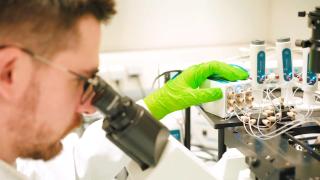
Innovation examples
ToxicologyIn vitroOrgan-on-Chip
Cartilage-on-a-chip for studying joint degenerative diseases
Carlo Alberto Paggi is currently a PhD candidate at the University of Twente in the research group of Prof. Marcel Karperien and Prof. Séverine Le Gac. Karperien’s lab focus on the biological aspects of osteoarthritic research while Le Gac’s specialize in organ-on-chip development. The project of Carlo Alberto is developing a joint-on-chip platform to create a reliable in vitro model to study disease progression in osteo- or rheumatoid arthritis. The model combines different organ-on-chips aimed at replicating each a tissue around the joint such as cartilage, bone and ligaments. This new technology focuses on better reproducing human models and at substituting the use of animal models for drug research. If you want to know something more about the project and the groups, you can follow the link in the video.
Carlo Paggi was nominated for the Hugo van Poelgeest prize for his research on a cartilage-on-a-chip model to study joint degenerative diseases
Karperien’s lab of Developmental Bioengineering: https://www.utwente.nl/en/tnw/dbe/
Le Gac’s lab of Applied Microfluidics for BioEngineering Research: http://www.severinelegac.com/
Linkedin: https://www.linkedin.com/in/carlo-alberto-paggi-76500b135/
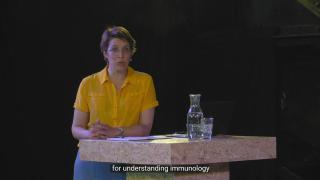
Meetings & conferences
HealthInnovationPolicy
Debate about animal testing
Animal testing contributes to advances in medicine and science in general. But in recent years people have increasingly questioned research using laboratory animals. The European Union and the Dutch government want to be a forerunner in the development and use of innovations that do not involve animal testing, but how do we want to achieve that? What are the challenges and opportunities for biomedical sciences? How do we accelerate the transition towards animal-free innovation? And what does this mean for research into better treatments for animals? In this debate Dutch leaders in the field of animal(-free) testing share their thoughts and opinions.
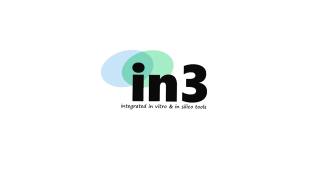
Projects and initiatives
HealthToxicologyIn vitroIn silicoOrgan-on-Chip
In3: combining in vitro and in silico for chemical safety assessment
The in3 project aims to drive the synergistic development and utilisation of in vitro and in silico tools for human chemical and nanomaterial safety assessment. The project focused on differentiation of human induced pluripotent stem cells to toxicologically relevant target tissues including; brain, lung, liver and kidney. The tissues, from the same genetic backgrounds, were exposed to common compounds and the data generated and prediction tools generated were used to develop modernised safety assessment approaches combining cheminformatics, mechanistic toxicology and biokinetics into computational models which can account for donor and tissue specific effects.